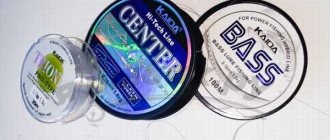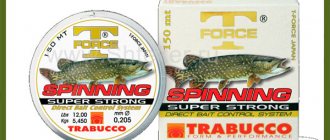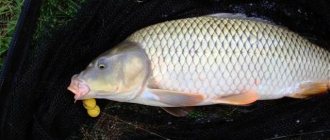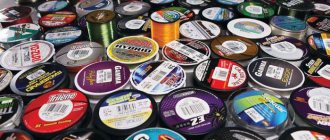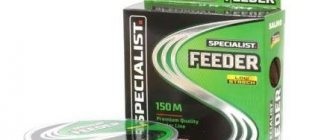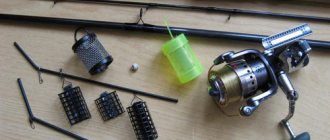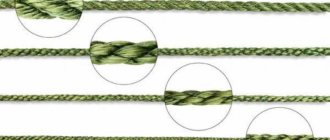Fishing line is an indispensable component of any carp tackle. The quality of bait delivery, casting distance and the success of fishing depend on it. We must not forget that it also determines the information content of the gear. Therefore, we decided to pay special attention to this element of equipment and find out how to choose a fishing line for carp fishing.
When installing equipment for carp fishing, you should pay attention to the choice of fishing line
Getting to know the tackle
Fishing line is one of the most important elements in fishing. In the late 80s, carp fishermen used a fishing line whose diameter was practically the same as a cable. The minimum cross-section was 0.5 mm - would you agree, a decent thickness? Since you have to deal with large and strong fish, the tackle must be strong, otherwise the predator will break loose and swim away.
Many manufacturers use modern technologies, thanks to which the line for carp fishing is produced much thinner. Some beginners are interested in why it is recommended to use fishing line rather than cord when fishing for carp? The fact is that the cord is not able to stretch, and this ability is very important at the stage of landing fish. If the tackle does not stretch, it cannot dampen the strong jerks of the fish. As a result, the carp will either come off or break off. Unlike other fishing lines, carp fishing lines have a larger unwinding line. In some models, this parameter can reach up to 1 thousand meters, since it is not always possible to predict how far the fish will go when biting and playing. Reels for carp fishing are large in size, which makes it possible to place more line in them. When choosing this gear, you need to take into account several parameters, which you will learn more about below.
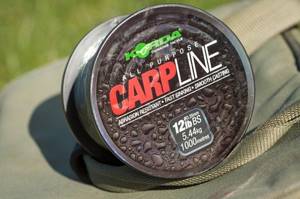
Top 5 best fishing lines for carp
Choosing a fishing line or braid for carp hunting is a complex process. There are many brands on fishing counters, including budget and professional threads. Below we give a rating of the best models used in our reservoirs when fishing for carp of all sizes.
Shimano Technium
A high-quality monofilament thread with a universal orientation, which can be recommended to carp anglers. Durable, abrasion resistant, durable. When fishing, it stretches well, dampens the jerks of the carp, preventing it from breaking the tackle or getting off the hook.
Climax Cult Carp Line
Durable, highly specialized cord. Designed for targeted fishing of large carp. It is distinguished by high flight performance, has moderate stretch, transmits fish bites well, is not afraid of knots, is durable and wear-resistant.
We recommend reading: Catching pike perch with amphipods
Sufix XL Strong
Model for hunting large prey and fishing in difficult conditions. It can be used in snags, among algae, in the current. It has high abrasion resistance, durability, tensile strength, and minimal memory.
Trabucco K-Karp Hi-Flow
A good product from an Italian fishing company. The brand is popular among floaters, but carp anglers also highly appreciate its fishing lines. The presented model is quite soft, flies well, has minimal memory, and can withstand decent loads. Belongs to the mid-price segment.
Korda Touchdown
Inexpensive carp nylon that is suitable for beginners. Durable, not afraid of contact with driftwood and shells. The stretch is medium, but enough to absorb the jerks of the fish. This monofilament allows the use of different knots and is combined with fluorocarbon and braid.
Color
Carp are fished using both transparent lines and those painted in different colors. Green and brown are considered the most common, since they are least noticeable in the water column. Some manufacturers are experimenting and making their products less noticeable. Relatively recently, camouflage gear appeared on the shelves. The peculiarity of such fishing lines is that they are painted in several colors, successively replacing each other. In such products there is no one continuous line. Visually, the tackle is divided into several short segments.
Material
Monofilament fishing lines are considered the most popular. The tackle is equally suitable for any type of fishing. Nylon is used as a material for the manufacture of monofilaments - a fairly durable, transparent and elastic material. The downside is that the fishing line has a memory effect, deteriorates from ultraviolet radiation and loses strength at the knots. To improve its properties, a silicone or fluorocarbon coating is applied to the fishing line.
Experienced fishermen use braided line to catch carp. This type of fishing line consists of a cord that is twisted from polyethylene fibers. The advantages of braids are their high strength and minimal elongation. The disadvantage of this type of fishing line is that it is poorly resistant to abrasive action. Mostly braids are used with feeder gear and jig spinning rods.
Durable fishing lines for large fish are made from fluorocarbon, a polymer material based on carbon and fluorine. Fluorocarbons, judging by the reviews of fishermen, are very resistant to abrasion and do not have a memory effect. In addition, of all types of fishing lines, it is these tackles that are least noticeable in the water column. True, despite the presence of undeniable advantages, fluorocarbon forests are not without some disadvantages. For example, they tear quite easily, but are expensive. For carp fishing, leashes are mainly made from lines of this type.
Which material is better
In modern carp fishing, you cannot achieve a good catch without the right fishing line. In this case, the first thing you need to pay attention to is the material from which it is made. The most popular today:
- nylon monofilament;
- fluorocarbon;
- braided cord.
It's easy to find pros and cons of each option. For example, braided cord outperforms its competitors due to its increased tensile strength. It turns out that a braid of a smaller diameter can withstand the same load as a fishing line of greater thickness. However, its stretchability is minimal. As a result, when a large carp (10 kg or more) bites, the cord simply breaks. Since the shock-absorbing properties of such material are not enough for successful fishing.
Therefore, carp anglers prefer nylon monofilament fishing line to braided cord. It stretches well, but at the same time has high strength. But nylon also has disadvantages. For example, monofilament material, due to its excellent stretchability, transmits bites worse. In addition, with tackle with a nylon line it is more difficult to make a long cast and hit the catch point (it happens that literally every meter of the distance of the bait from the shore is important). After all, due to good shock absorption, part of the energy is extinguished.

Nylon monofilament fishing line is often used for carp fishing.
What can you say about fluorocarbon? This is an excellent and necessary material for carp fishing line. Fluorocarbon rigs are virtually invisible in the water. She also manages to sink quickly and not create excessive windage. In addition, fluorocarbon fishing line is characterized by high wear resistance, long service life and resistance to mechanical damage. However, the angler should remember the following:
- The elongation of fluorocarbon is worse than that of monofilament line.
- It is also inferior to monofilament in terms of breaking load.
- The cost of fluorocarbon fishing line is quite high, but it’s not worth saving. We recommend only products from famous and trusted brands.
- To catch carp weighing from 3-4 kg, you already need to take a fluorocarbon line with a cross-section of 0.35 mm. Otherwise, it may tear when playing.
Which fishing line is better out of all the options listed? It's hard to say. After all, a lot depends on the fishing conditions, and on the type of gear (donka, feeder, float, etc.), and on the skills of the fisherman himself.

You can also use fluorocarbon fishing line for carp fishing.
For a beginning carp angler, we recommend using high-quality monofilament – its stretchability will help avoid fish escapes when fishing. Experienced fishermen should try different options and thereby decide which fishing line is best for them.
About purpose
For rigid rods with a fast action, an elastic and highly stretchable fishing line is ideal. For soft fishing rods, experts recommend choosing a line that is less stretchable. If you fish with a soft parabolic rod, on which a strong stretching line is installed, difficulties may arise during fishing. The fact is that the fish in this case will have greater freedom of action. If you install braid on a rigid rod, the drag of the reel will be subjected to serious stress, as a result of which it will last less.
Korda Touchdown
This popular carp fishing line takes the leading position and represents a series of tackles with the highest degree of sensitivity. In the manufacturing process, the manufacturer decided to use a hard, wear-resistant, low-stretch material. According to experts, the gear has optimal flight characteristics. Judging by consumer reviews, all scaffolding from this series have good load-carrying capacity and are resistant to jerking. In the entire line, the thinnest is carp fishing line with a diameter of 0.4 mm. With its help you can catch fish weighing 6.3 kg. The thickest tackle can withstand a load of no more than 9.1 kg. The reel contains 1,000 meters of scaffolding. The tackle is brown, which camouflages it well at great depths. According to fishermen, 150 m will be enough for fishing, which is enough for two seasons. The only drawback of carp fishing line is that it is very expensive. The price of one reel is 2819 rubles - quite an impressive amount for many.
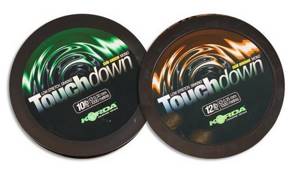
Line thickness
The cross-section diameter is one of the most important parameters. As a rule, carp fishing uses a fishing line with a thickness of 0.2 to 0.5 mm. As you can see, the spread in the cross-sectional diameter is quite large. Therefore, it is sometimes difficult for a novice fisherman to understand what thickness of fishing line is best to take for carp fishing. To make it easier for you to understand all the nuances, remember the following:
- The thinner the fishing line for carp, the further you can cast the rig. Therefore, if you need to fish from the longest distances, it makes sense to reduce the thickness of the thread. The main thing is not to the detriment of fishing and the fish themselves. After all, a carp can easily tear a thin fishing line. Thus, he will not only avoid a long-awaited meeting with a fisherman, but may also suffer due to the equipment with a hook remaining in his mouth.
- The running size of the fishing line is 0.28-0.32 mm. This thickness of cord or monofilament is enough to catch carp weighing up to 10-12 kg. For trophy fish, it is better to equip the tackle with a fishing line with a large diameter. For example, about 0.4 mm.
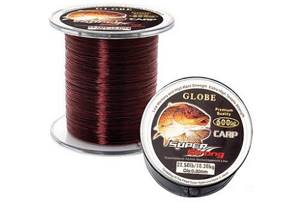
The thickness of the fishing line should be selected depending on the expected weight of the carp and the place where it will be caught.
- You need to choose a fishing line based on thickness taking into account the fishing characteristics. If this is a heavily charged pond, then you cannot do without a cord or monofilament with a cross-section of 0.32-0.4 mm. Otherwise, there is a high risk of the rig being torn off by getting caught on some submerged branch. Just don’t forget that the larger the diameter of the fishing line, the stronger it sails. You can cope with this by increasing the weight of the sinkers. If you fish on reservoirs with a “good” bottom, then using thick fishing line is not recommended. It will only have a negative impact on the bite.
- Under any circumstances, you should not use fishing line thicker than 0.4 mm. It will not allow you to control the bait, feel the bite and normally cast the equipment without heavy sinkers. In addition, a thick fishing line is noticeable to fish, and its additional strength is absolutely not needed by a carp angler. Even when fishing for trophy specimens.
Climax Cult Carp Line Z-Sport
The fishing line for carp rods from this company is used in sport fishing. It ranks second in the ranking of the best. The line includes products only with a 0.25 mm cross-sectional diameter, which allows you to significantly increase casting distance, since thin line comes off the spool easier and has less resistance. The optimal load for them is considered to be 5.8 kg. The gear comes in copper brown, fluorescent yellow and orange. To make the core of carp fishing line, elastic nylon is used, which consists of fluorocarbon. This material, according to experts, is very resistant to wear, stretching and ultraviolet radiation. The advantages of the gear lie in the combined composition of nylon and carbon and the ability to make ultra-long casts. To become the owner of an excellent carp fishing line, you will have to shell out 1,640 rubles.
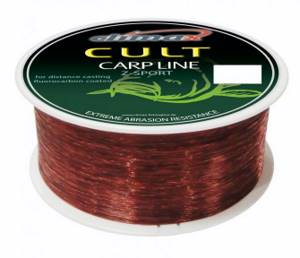
Choosing a fishing line for carp fishing
Content
Carp fishing line, regardless of the fishing method, should be strong and inconspicuous.
The remaining, often mutually exclusive, characteristics are determined by the type of carp fishing:
- In carp fishing, monofilament lines with high elasticity are used mainly, which ensures that the jerks of the fish are countered. In principle, any monofilament line of the appropriate diameter is suitable for fishing with carp tackle, but it is optimal to use a specially designed fishing line for a carp rod from European or Japanese tackle manufacturers.
- A carp line for a feeder should, on the contrary, have minimal elongation to capture the most careful bites. That is why in feeder fishing, as a rule, braided fishing lines are used. The breaking load must correspond to the average size of carp in the reservoir.
- The fishing line for carp fishing using float gear must meet the requirements of a specific fishing method. For example, in match fishing, sinking lines are used, and in Bologna fishing, floating lines are used.
Thus, to the question: “Which fishing line should I choose for carp fishing?” It is impossible to answer unambiguously, just like the questions “How to choose a spinning reel?”, “Which hook is the best?” and other related to choice. The answer to such questions depends on the fishing conditions and the financial capabilities of the fisherman. It is much more correct to determine whether the characteristics of the fishing line correspond to the characteristics of a particular type of fishing.
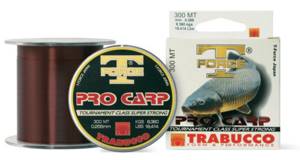
Nylon carp line stretches well and has good strength at low thickness
Fox Torque Line Green
The tackle appeared on the shelves of specialized stores in 2016. Judging by the reviews, a fishing line with a 0.30 mm diameter has a rather low load capacity and can withstand no more than 5 kg. The disadvantage is compensated by high casting ranges. To reduce the friction of the tackle on the rings when it comes off the spool, the manufacturers made the surface of the line smooth along its entire length. The product is produced in green color, making it hardly noticeable in the pond. If you compare it with previous models, then this carp line costs less - 1099 rubles. Judging by the reviews of anglers, Fox Torque Line Green takes an honorable third place.
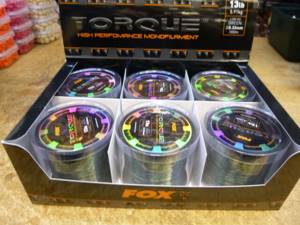
The above three brands of fishing line are considered expensive. Judging by the reviews, not every fisherman can afford to purchase them. Next, we will talk about budget carp lines, which, according to fishermen, are considered the best in the inexpensive segment.
Daiwa Ginro Silver Beast Nanodis
It occupies a leading position among budget products. The price of monofilament fishing line is 500 rubles. The gear has a fairly high breaking load - 5.4 kg. To achieve this result, the manufacturer calibrated the diameter of the line along its entire length. The product has a weak “memory”, so when creating strong knots, total bends do not form. On the other hand, many consider this feature to be a disadvantage. This monofilament is best used with spinners, tails and wobblers. The tackle can be used for catching large trout.
Braided fishing lines have deservedly won their place
In modern carp fishing, braided lines have deservedly won their place on the spools of marker and spod rods, but the number of anglers using “braid” as the main line for direct fishing is not so large. Is braided line really not at all suitable for carp hunting and its use in carp fishing is strictly limited to use on auxiliary rods? Let's figure it out.
One of the main characteristics of braided fishing line is the complete lack of stretchability, while monofilament fishing lines are elastic. That is why “braids” are much more sensitive than monofilament (with the exception of fluorocarbon, which does not have significant stretchability). To be convinced of the superiority of braided fishing line over monofilament in terms of sensitivity, it is enough to make one sweep along the shore with a marker sinker - the sensations will be radically different. Anglers hunting for predatory fish quickly realized the advantage of such sensitivity for recognizing a larger number of bites, often hooking at the slightest push or blow.
No stretchability
The lack of stretch of braided line is very important when fishing near high-risk areas. Snags, flooded forests and individual fallen trees are the favorite habitats of carp, in which bites occur very often. However, you should not endanger the lives of carp, and simply count on successful fishing by fishing at random. Using a monofilament line with a cross-section of 0.3 mm for fishing at a distance of 100 m from the shore near an underwater snag is a guaranteed breakage of the gear due to the low breaking load of the monofilament and its stretchability, which will not allow you to instantly respond to a bite. To verify the above, you can unwind 100 m of line in the field and you will be amazed at the freedom of movement due to the elasticity of the monofilament. You can walk several meters without any problems, and even the most sensitive swinger will not move. Now remember, has it ever happened to you that the signaling device made one or two peaks, you did not pay attention to it, believing that a fish swimming by was touching the fishing line, and when reeling in the rod, the tackle was in a dead hook? Most likely, the carp was tempted by the bait and was reliably hooked, but insufficient attention when choosing the main fishing line was the main reason that all this happened without your knowledge. When using a “braid”, the slightest movement of the sinker is transmitted to the swinger and the alarm, so there is no doubt about “false” peaks.
Trabucco K-Karp Hi-Flow
Large unwinding carp line. The reel contains 600 meters of black fishing line. The model has all the qualities and properties that will make fishing as effective as possible. Judging by numerous consumer reviews, tackle with a diameter of 0.286 mm is very resistant to abrasive damage and quite flexible. Many people appreciated its optimal stretchability, so a fisherman can take it to hard-to-reach places in the reservoir and to snags. The breaking load is 7.15 kg. High characteristics brought the tackle to second place in the budget rating.
Bercley Fire Line Micro Ice Fused Original
German-made gear allows you to fish for carp both in winter and in summer. Since the line is of high quality and transparency, even the most careful predator may not notice it. The fishing line has minimal elongation, and thanks to its high sensitivity, it is convenient for the fisherman to control the retrieve and bite. Products with breaking load from 1.5 to 4.8 kg. This parameter depends on the cross-section of the scaffold. According to fishermen, the tackle is quite catchy, since it is used to fish not only for carp, but also for pike, pike perch, perch, and ide. The price of the gear is relatively low - 440 rubles. In the ranking in third place.
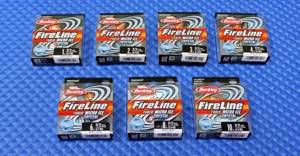
Breaking load and elongation
In addition to the cross-sectional diameter, carp fishing line has other important parameters that every fisherman needs to know about.
Firstly, this is the breaking load. As a rule, it is indicated on the reel itself. And not always in kilograms. In European style, many manufacturers indicate the breaking load in libs. Abbreviated as lb. What do they mean? We won't go into details. Just remember that one lib is approximately 450 grams. Therefore, on most carp fishing lines the following breaking load parameters are indicated - from 6 to 20 lb. That is, from 2.7 to 9.1 kg. This is enough to catch carp weighing up to 12-15 kg. After all, almost all high-quality fishing lines have a safety margin.
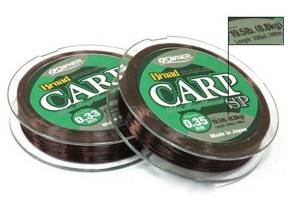
When choosing a fishing line, you should take into account the breaking load
Secondly, we must not forget about such a property as stretchability. In modern carp lines this figure ranges from 5 to 20%. More stretchable cords and monofilaments better retain strength at the knots, improve casting distance, and reduce the load on the rod itself and all the gear when fishing. However, they have low wear resistance and lose their properties faster. It is best to use fishing lines with high elongation in “clean” water areas. If you plan to fish among snags and various edges, then you should abandon them. Otherwise, when fishing, you will not be able to quickly move the fish away from obstacles. Low-stretch lines also allow for better hooking. Therefore, they are also good for catching cautious fish.
What conclusions can we draw from all of the above? At a minimum, the following should be considered:
- In addition to thickness, the fishing line has a number of other important parameters. One of them is breaking load. It is also recommended to pay attention to this indicator when choosing a cord or monofilament for carp fishing.
- If there are obstacles, it is advisable to use a low-stretch line. It will allow you to quickly transmit the bite and avoid the carp jerking to the sides, where it can get off, getting caught in bushes, snags, etc.

When choosing a fishing line material, you need to pay attention to its stretchability
- If the fish is extremely cautious and it is not possible to make an effective hook, then it is best to also use a low-stretch line. Thus, there is a greater chance that the carp will hook itself.
- Highly tensile fishing line is good for catching active fish and in water areas with a clean bottom. In addition, it is indispensable if your goal is a carp trophy. After all, such a fishing line has excellent shock-absorbing properties, due to which it dampens the jerks of the fish.
Salmo Tournament Team
It is considered a high-quality monofilament fishing line, the diameter of which varies between 0.102 - 0.223 mm. On the market, fishing line is presented mainly in spools of 50 meters. It is less common to come across reels with 75 meters of line. Many fishermen consider this, albeit small, but a minus. The main feature of Salmo Tournament Team is that the fishing line has a special protective layer that eliminates the memory effect. In addition, it prevents abrasive wear of the gear. The fishing line has water-repellent qualities and remains elastic even at temperatures of -20 degrees. To purchase one reel, you will have to shell out 350 rubles.
Getting to know carp
It’s worth getting to know this interesting fish better in order to understand what line to use and when to use it.
Habitat
Carp lives in reservoirs rich in vegetation with soft soil, with stagnant or low-flowing water. A depth of 2-8 meters is the most comfortable for carp to live. He likes places with shelters in the form of algae bushes, snags, and holes.
Expert opinion
Knipovich Nikolai Mikhailovich
Zoologist, hydrobiologist. I am interested in fishing at a professional level.
Important. Large adult carp are solitary fish. Only in his youth does he prefer life in a pack.
Diet
Carp is a typical representative of benthophages , i.e. fish that feed on invertebrates living at the bottom of the reservoir. Carp also does not disdain plant foods - algae, vegetables, plant grains. The special structure of the carp's mouth helps it grind even the shells of mollusks and filter food from solid particles.
Hearing and smell
Carp have very sensitive antennae and good hearing , which allows it to feel and hear the movement of an invertebrate in the ground from a distance of up to 20 meters.
Seasonal activity
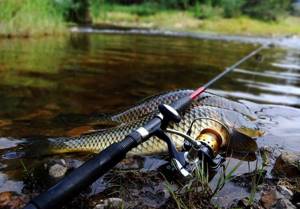
Carp feed from April to October.
In early June, carp feed around the clock, restoring strength after spawning.
With the onset of heat, the fish switches to feeding at night, but during periods of cold weather and rainy weather it can show interest in food all day long.
At the very end of summer and at the beginning of autumn, carp prepares for hibernation and switches to increased feeding, losing caution and paying little attention to everything except food. This is the time when carp anglers have the richest catches.
From November to March, carp gather in schools and hibernate in holes at the bottom of the reservoir.
Fighting character
This smart, strong fish fights for freedom until the very last moment . Constant resistance, strong and sudden jerks, constant attempts to find shelter are characteristic of the behavior of carp. Given the weight of the fish, getting it to shore is no easy task. Even a thick monofilament fishing line, the clever carp will try to break it by catching it on a snag.
In addition, carp is a cautious fish (except during the autumn feeding season). Before decisively grabbing the bait, he “sniffs” it properly. If he doesn't like the color of the line sticking out of the bait, he will most likely turn away from it.
Expert opinion
Knipovich Nikolai Mikhailovich
Zoologist, hydrobiologist. I am interested in fishing at a professional level.
Interesting. The heaviest carp was caught in Hungary in 2015. The carp weighed 48 kg (https://carpfishing-media.com/2015/11/10/12-samyh-krupnih-karpov-mira/).
Sufix Duraflex X10 Clear
You can buy fishing tackle for only 300 rubles. It was the low cost and relatively acceptable quality that allowed it to be included in the budget segment rating. Experienced fishermen say that these are forests with fairly good, but not standard, characteristics. It is quite soft and flexible, but this does not prevent you from weaving strong knots from it if necessary. With almost zero elongation, the wood has tolerable sensitivity. The cross-section diameter is 0.25 mm. If the load threshold exceeds 7 kg, the scaffolding will break. The main problem with Sufix Duraflex X10 Clear is the non-uniform cross-section, which is especially noticeable during unwinding.
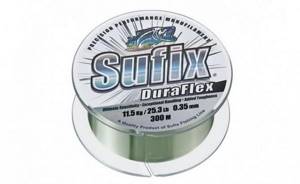
As a result, a predator can suddenly break it off even at a lower voltage, which causes frustration and bewilderment for the fisherman. This drawback is noted by almost all fishing enthusiasts, but the low price smoothes out the unpleasant experience.
Source: fb.ru
